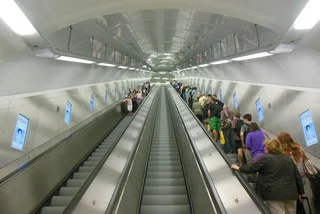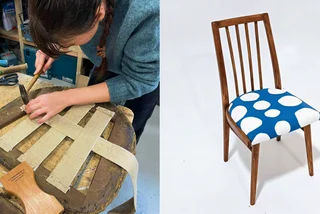Long-term Prague residents may have noticed that their commutes have gradually gotten a bit longer. That is due to the escalators in the metro stations slowing down. By 2030, all of the original Soviet-style escalators will be replaced with safer – meaning slower – ones.
When the bulk of Prague’s metro system was built, starting in 1974 with the C line, safety rules were a bit vague. But since the Czech Republic joined the European Union in 2004, new standards began to apply. Due to these rules, the Prague Public Transit Company (DPP) shortly after EU entry began to cut the speed to 75 cm per second or less to meet the European standards.
PARTNER ARTICLE
Just how fast the escalators used to go oddly is a matter of dispute. In 2009, then-City Councilor Radovan Šteiner, responsible for transport, said some escalators went over 200 cm per second (or 2 meters per second), but DPP only confirms a top speed of 90 cm per second for the Leningrad-type escalator.
“From the point of view of passengers, higher speeds are pleasant, but from the point of view of safety it is a problem,” he said at the time.
There are now 268 escalators in the Prague metro system. Of these, some 40 original Leningrad-type escalators are still functioning in 2022.
In current practice, there are four speeds in operation in Prague’s public transit escalators: 90 cm per second for the original Leningrad type, and 75, 65, and 50 cm per second for newer ones.

While the change in speed doesn’t sound like a big deal, Prague’s A line is home to some of the longest escalators in Europe, with the one at Náměstí Míru being Europe’s longest, some 87 meters long. Currently, the trip on the escalator takes 2 minutes and 20 seconds, equaling 62 cm per second. At 90 cm per second, the same trip would be about 1 minute and 37 seconds.
This adds up to over 14 minutes per work week, counting two trips a day. Every month, that’s an extra 56 minutes in the escalator.
In recent years, Leningrad-type escalators have been replaced at Náměstí Republiky, Karlovo náměstí, and most recently at Anděl. An art exhibition opened in the Anděl metro, coinciding with the end of renovations there.
Another long project that involved installing a new escalator was at Národní třída, which was renovated between 2012 and '14.

The next original escalator to be replaced will be at Jiřího z Poděbrad, which will be closed for 10 months starting in January 2023. Stations with two main entries to the platform can stay open during the replacements. Jiřího z Poděbrad has only one main entry so it has to close completely.
Currently, the 73 meter trip on the Jiřího z Poděbrad, the escalator takes one minute and 20 seconds, coming close to 90 cm per second. The DPP has not announced the speed of the replacement, but taking the middle option of 65 cm per second, the trip would take one minute and 50 seconds.
This adds about five extra minutes a week to the journey time, or 20 minutes a month, assuming the person gets to the platform just in time to catch to train.
The reasons given by DPP for changing the escalators are not only to reduce the speed and increase safety, but also reduce energy consumption and related pollution, save energy and maintenance costs, reduce service outages, and increase the attractiveness of urban public transport.
Slower speeds cause wear less wear, so the escalators can go longer without needing service. The newer models also include built-in sensors to monitor the speed of both the stairs and the handrail, and other technical innovations.
Safety is a big factor, as many people, especially the elderly, struggle with the fast-moving stairs.
“Last year, Prague rescuers went on 127,000 calls, and about 300 were falls on escalators. These are mostly injuries of the upper and lower limbs, and very often there is also a facial injury when people hit their faces against the rough surface of the escalators,” Prague rescue service spokeswoman Jana Poštová told news server Pražská Drbna. Most cases were not serious but a few ended in intensive care.
The handrail runs faster than the stairs as a way of preventing injuries. It is supposed to make the passenger pay attention. It essentially nudges someone if they start to fall asleep standing up. The rules of carriage, which passengers automatically agree to when buying a ticket, require people to hold one of the railings while on the escalator.
There is a convention that people should stand on the right side and leave the left side open for people who want to walk up or down the escalator. DPP says this unbalances the inner mechanisms, causing the escalators to break down more often. Standing is safer for both passengers and the escalator.
Czechoslovakia was late to the escalator game. They were first patented in 1859 in the U.S. state of Massachusetts, but a working one wasn’t built until 1896 in New York’s Coney Island. They weren’t seen in Bohemia until a quarter-century later when a covered moving stairway was put on the side of Letná hill in Prague, replacing a previous cable car. It ran from 1926 to ’35. It can be seen in the 1931 film "Men From Offside" (Muži v offsidu).
The first conventional one opened in 1934 was in the Baťa department store in Zlín. Prague got an indoor one on March 19, 1939, at the Bílá labuť department store on Na Poříčí Street. Before the metro existed, there was an escalator in an underpass on Wenceslas Square in 1968. The first metro escalator in Prague was at the Hlavní nádraží stop. It went into trial service in September 1973.












 Reading time: 4 minutes
Reading time: 4 minutes 































